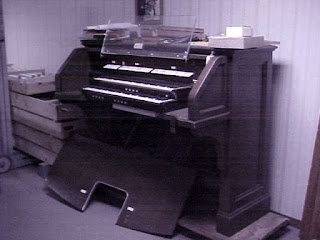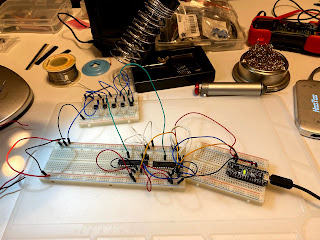Two Steps Forward, One Step Back

I finished the pedalboard, with all the components screwed down and the wires taped together and stowed neatly, and installed it to the main console - with USB and power/ground/reset wires connected and dis-connectable to remove the pedalboard.
The signal lines go into headers so they are easily inserted/removed. There is some linen twine keeping each group organized and in order.
I am regretting making the signal lines soldered at the sensor end. The reed switches are delicate and I've broken a few in my over-enthusiasm to get this all built. New ones I put in have female header to make replacement easier.
I spent a nice hour or two just playing on Friday evening, and it was lovely.
So, on to the manuals!
Here are the electronics for the Great. The controller is on the longer board on the left, along with two port expander chips and angle header connected to the input pins - 8 on each side of each chip. The right has just expanders. I separated them this way to reduce the amount of wire needed from the sensors.


Here is where I am installing into the organ. The electronics have such a low profile they are able to fit in the narrow space between the Great and Swell right here but still have good air circulation for cooling. The only problem is the contact wires from the original keying system are conductive and could cause trouble. I could remove the whole assembly easily with two screws, but the bars and springs are a part of the mechanics of the key touch and they just don't feel right without them. Fortunately the could be removed, along with the slider bar thingies, by unscrewing only about 35 screws from the bottom.
This was annoying, but not difficult. Here I have the electronics wired together, and to the pedalboard. I used twine to tie the boards to the wooden dowels because there was no good way to screw them down without interfering with the motion of those contact bars, which would impact the feeling of the keys. It is strong enough, nonconductive, and linen - which I happened to have around, is rot resistant.
I have a small usb hub which I'm building into the organ. All the controllers will plug into it, and there will be one usb port to connect the computer to. Next step is test it out.
And ... here is where I realize I overlooked something important. I tested the pedalboard and my digital piano together a couple of weeks ago, and it was all good. I did not test connecting two arduino keyboards to my computer. They work and are both reachable, but the HairlessMidi serial usb software can only connect to one or the other at a time.
Some hours of research later, I have learned that what I should have done is used a controller based on the ATmega32u4 chip. I was using Adafruit Metro Mini's - largely because I am familiar with them and already owned a few. They have USB serial native, but are not able to do MIDI USB natively. This would make each arduino show up as a separate MIDI instruments, and let me avoid the need for Hairless MIDI entirely. All the VPO software I've tried is able to cope with multiple instruments coming in. That last bit is important because Hairless hasn't been updated in over 3 years
and will not run on MacOS Catalina. I've been concerned about this and not looking forward to doing the update and building it myself.
Teensy is a popular board to use for this purpose, but they are more than twice the cost of the Metro Mini's and I need three of them - four eventually when I implement the stop actions. I'm going to go with Adafruit's ItsyBitsy 32u4 at $9.95 each they are even cheaper than the Metro Mini. I have already modified my code to use the native MIDI library, and tossed out the serial midi library I'd been using. This is waysimpler, and I confirmed it compiles for the board I've chosen before ordering. I will need to do some de-soldering to remove the metro boards and the pinouts are different so I'll have to move some of the other wiring, but it really isn't that big a deal.
Meanwhile, while I wait for the order to arrive, I will build Hall sensor arrays. Sets of 8 with header wires to plug into my scanners - the change in controller will have no effect on them. All in all, while the initial discovery was disconcerting it isn't that big a setback and the final results will be much better long term.






bacon
ReplyDelete